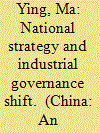|
|
|
Sort Order |
|
|
|
Items / Page
|
|
|
|
|
|
|
| Srl | Item |
| 1 |
ID:
128358


|
|
|
|
|
| Publication |
2014.
|
| Summary/Abstract |
This paper presents the evolution of the environmental licensing process in Brazil, with focus on transmission lines, identifying and evaluating its critical aspects. For this purpose, we analyze the modalities of insertion of the environmental variable in planning for the Brazilian electric power sector, present an overview of the complexities of energy transmission in the country and describe the evolution of the environmental licensing process, in particular its application to the Madeira transmission line, the world's longest high-voltage direct current line at 2375 km, which connects the northern and southern regions of the country. Finally, we succinctly describe the latest developments of the country's environmental legislation, presenting the advances achieved and future challenges.
|
|
|
|
|
|
|
|
|
|
|
|
|
|
|
|
| 2 |
ID:
144040


|
|
|
|
|
| Summary/Abstract |
During the past decades, there has been a shift in the governance structure of the power transmission and distribution (PTD) industry from a market-oriented scheme to vertical integration. Such a shift in industrial governance was driven by the change in national strategy from “market in exchange for technology” to “independent innovation”. Under this new policy paradigm, the ultra-high voltage (UHV) transmission technology was perceived as strategically important for the country. The State Grid Corporation of China (SGCC), whose control over the industry was initially reduced in the reform, leveraged the paradigm shift in the state policy and strengthened its position in the industry by redefining the main and auxiliary services. The State Grid successfully brought back all UHV industry-related services, such as power design, equipment manufacturing, power grid construction and capital operation, into its main business category, which could be exempted from market competition according to state regulation. Eventually, the State Grid was able to establish strong vertical integration in the whole sector.
|
|
|
|
|
|
|
|
|
|
|
|
|
|
|
|
| 3 |
ID:
132694


|
|
|
|
|
| Publication |
2014.
|
| Summary/Abstract |
Complex planning procedures often amplify the difference in investment time between generation and transmission. In this work we consider a transmission project in Italy and, relying on a recently proposed methodology, we compare costs and benefits of anticipating the planning process before the connection of new power plants becomes certain. Whereas the system faces lower congestion costs if the network is reinforced immediately, anticipation constitutes a sunk cost in case generation is not built. For realistic load and generation scenarios, anticipation costs, as well as differences in investment times, our results indicate that anticipation is the most efficient choice for a relatively low connection probability. Analyses of this sort are particularly relevant in light of the increasing complexity of public engagement processes and of the remarkable growth in renewable generation.
|
|
|
|
|
|
|
|
|
|
|
|
|
|
|
|
|
|
|
|
|